Introduction
This chapter deals with research findings, analysis and
discussion on women's health merits and demerits as well as negative impacts of
non-health provision in Butembo District. The results of the study carried out
in Butembo District from 25th May to 6th July 2007 are
presented in consecutive diagrams.
WOMEN'S HEALTH IN POST WAR
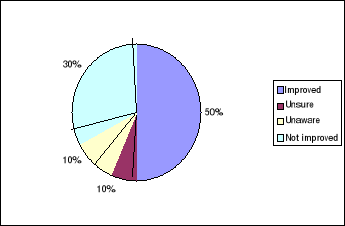
Figure 4.1: Women's health in post
war
The 10% shown on pie chat figure below, women stated, they
were unsure of their health status. This number of 10% if extrapolated over all
areas inflicted by war would be substantial and Health services may not
recognize or identify the causes of this uncertainty. This uncertainty may be
due to the situations these women found themselves during the conflict.
Fifty per cent stated that their health has improved. It is of
major concern that 30% claim no improvement in their health status. The most
serious and worrying issue is that 10% are unaware. This has major implications
for the future health of families and especially children, (FEPSI-NGO,
2007).
WOMEN'S MAJOR HEALTH PROBLEMS
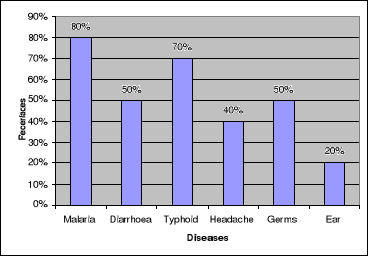
Figure 4.2: Women's major health
problems
As seen in figure 4.2 above, women stated illnesses which are
regular and not specific to war conditions, and there are no direct signs of
post traumatic stress disorder. The only notable illness that requires more
attention is headache, seen by the fact that 40% of the women said they
suffered regularly from this and is a symptom of stress. The worrying aspect of
this finding is that it is clear that health services are not addressing the
common disorders and moreover that mosquito nets that prevent malaria are not
used. All the diseases mentioned by the women are preventable.
Why women are experiencing these problems seems to be due to
the fact that there are no health promotion activities and although FEPSI is
treating the women, there is a gap in health services that would promote
women's health and educate the communities on ways to prevent illness.
WOMEN'S BETTER HEALTH CARE
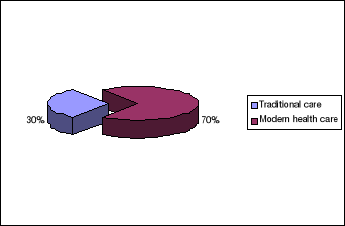
Figure 4:3. Women's better Health
care
70% of the Women interviewed go for modern treatment (as for
example in the FEPSI hospital). The other 30% (15/50) were influenced to use
traditional medicine for a number of reasons such as lack of money for
transport [even though treatment for instance in FEPSI hospital was free] or
because they believed the traditional medicine were found in the areas where
they live. Moreover, they have been using them for decades.
However, this figure clearly illustrate that the women were
ready to use the medical facilities especially if they were free, but also
because the services that are provided were influenced by the doctors
competency, fast services, skills and experiences.
CHALLENGES ENCOUNTERED IN TREATMENT
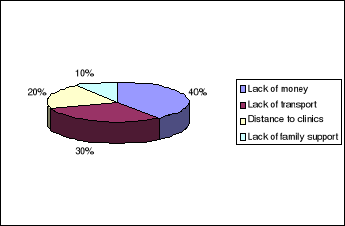
Figure 4.4: Challenges encountered
in treatments
Even though the FEPSI facility treatment was free, the women
still felt that the availability of money for health was a major set back
[Figure 4.4 above]. Caught with the long distance to this facility, shows that
access to services is still problematic even after over 4 years of peace in the
area. Health services are still few and women have long journeys to make to
seek services that they can afford.
WOMEN'S FORECAST ON HEALTH GROUNDS
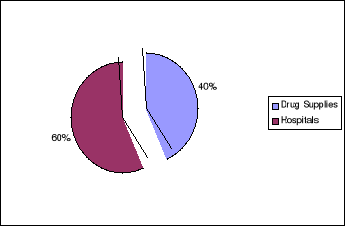
Figure 4.5: Women's forecast on
health grounds
To solve the above problems, solutions mentioned by the women
could be to construct more clinics (60 %) and to improve drug supplies (40 %).
However, construction requires a strong and resourceful health sector. This
can only be achieved with a country at peace and a steady and growing economy.
Also, the presence of health workers would be a help to the women.
WOMEN'S MOVEMENT DURING CONFLICT
40%
60%
Those who stayed
Those who fled

Figure 4.6: Women's movement
during conflict
Sixty percent (60%) of the women fled the town during the
conflict to the villages; thus health care remained poor. This resulted into
Women moving between the villages and towns, thus increasing their risk to the
consequences of war, since it was only in town that health services were
available.
HEALTH SERVICES DURING THE CONFLICT
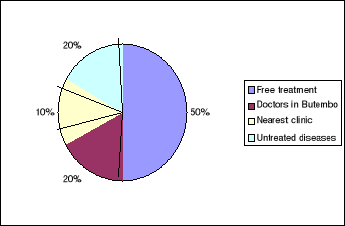
Figure 4.7: Health services during
the conflict
Fifty percent (50%) of Women stated they were getting free
treatment that helped them to maintain their health at normal levels but to
improve one's health conditions is the affordability of one's financial
positions. That is why. This situation was reported by 50% of women who do not
have access to afford a high health treatment.
USE OF MEASURES BY THE WOMEN TO MAINTAIN THEIR
HEALTH
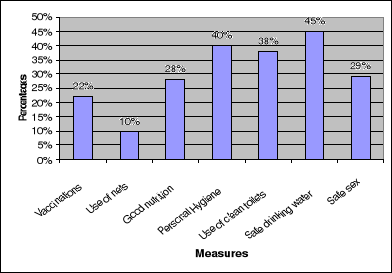
Figure 4.9: Use of measures by the
women to maintain their good health
It is clear that the women want good health for themselves,
and their families, but the constraints shown before in figure 4.4 clearly
indicate that they come to FEPSI because the treatment is free and they have
access to qualified doctors. As FEPSI not only treats, but offers health
education it is not surprising that the women know what they want and need to
have good health. These needs are there and some women try to go for it.
Nevertheless they need to attend more regularly to be realized. They need a
systematic response from all the sectors of government.
In conclusion the findings were based on the objectives.
CHAPTER FIVE
DISCUSSION, CONCLUSION AND RECOMMENDATIONS
| 

